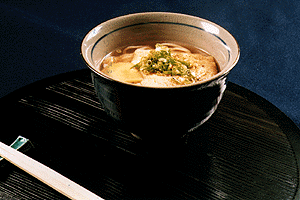| Asked what is the representative food of Osaka, most people would suggest takoyaki (griddled octopus balls), okonomiyaki (savoury pancakes) and kitsune udon. Personally, I'm not comfortable with this selection of what are basically just snack foods. Apart from my feelings, it is questionable whether these three items really represent food that is distinctly Osakan. But we can explore the reasons why kitsune udon is generally considered to be a typical dish from Osaka. I think there are two reasons: its origin and its taste. Firstly, its origin. Kitsune udon is now the most popular type of udon noodles. It is available throughout Japan, and I'm sure everyone has had it at least once. It is called Shinoda udon in some areas. Kitsune udon originated in Osaka. It was invented during the Meiji period (1868-1912) by the founder of a restaurant called Matsubaya in Minami Semba. Before starting his own business, Yotaro, the founder, worked as an apprentice in a restaurant called Takotake on Matsuyamachi Street in Osaka. The restaurant still exists. At that time, Takotake served both udon and sushi, although it is now solely a sushi restaurant. (I love their conger eel sushi!) When Takotake stopped serving udon, Yotaro decided to start his own udon restaurant. The owner of Takotake suggested he try making a new type of udon, and so Yataro invented kitsune udon. His idea of serving udon with deep-fried tofu (age) came from inarizushi, which is vinegared rice wrapped in sweetened deep-fried tofu skin. Originally, Yotaro's restaurant served a bowl of udon accompanied by a bamboo basket containing fried tofu and fried fish balls. But customers repeatedly put the fried tofu in the bowl of udon, and after a while the restaurant served it in the bowl with the udon. Initially, two pieces of fried tofu were served. This was because deep-fried tofu was often offered to a pair of stone-carved foxes (kitsune) guarding an Inari shrine in the belief that it was their favourite food. The twin foxes symbolise the concepts of Yin (negative) and Yang (positive), and the beginning and end of the universe. The two pieces of fried tofu also symbolised a happy marriage. So much symbolism hidden in a humble bowl of noodles! In any case, that is how kitsune udon was invented. The second point to consider is its taste. I don't think kitsune udon should be considered a typical Osakan dish solely because it originated here. If it didn't taste good, people would have simply ignored it. Osaka's kitsune udon tastes better than that of other areas because the basic stock is superior. Stock is treated as a high priority in Osaka cuisine. Kansai food in general is lightly flavoured, partly because good stock does not need heavy seasoning. Clear soup made in people's homes tends to contain more soy sauce. This is partly because it goes with the rice, but the main reason is the stock. If the stock is not good, it will need extra flavouring with soy sauce. But stock made with high-quality kombu kelp and dried bonito tastes superb just slightly seasoned with salt and soy sauce. For kitsune udon, kombu of the highest quality and several kinds of dried fish flakes (bonito, mackerel, etc.) are used to make a rich, savoury stock. Light soy sauce and salt are the only seasonings needed. The Osaka style is to season the broth so lightly that people will want to finish every last drop. Of course, the noodles are also important, but in my opinion, the taste is 80% determined by the stock and only 20% by the noodles. I think these are the reasons kitsune udon is considered to be a typical Osaka dish. | 